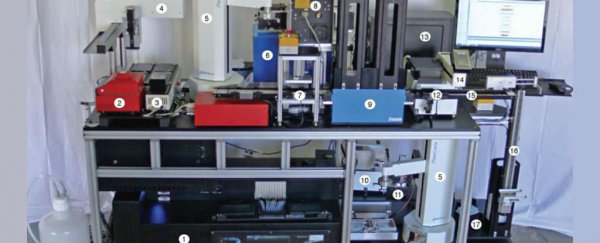Back in 2016, biologist Craig Venter achieved something extraordinary. He built a new species of bacteria from scratch in the lab - the simplest genetic life form known to science, made entirely through chemical synthesis of a custom-made genome.
Now, he's unveiled a new machine that could print these synthetic life forms on demand - simply feed in a genome design, and let the 'ink' form the building blocks of life. The invention could see us colonise Mars with synthetic life without ever setting foot on the Red Planet, and Venter and Elon Musk have teamed up to make this happen.
Called 'biological teleportation', the technique could allow scientists to email the genome from Earth to a printer on Mars, theoretically allowing us to colonise the Red Planet from afar.
"I think biological teleportation is what is going to truly enable the colonisation of Mars," Venter told his biographer Ashlee Vance back in 2015.
"Elon and I have been talking about how this might play out."
The new tabletop prototype, called the digital-to-biological converter (DBC), is the first machine that can receive genetic sequences via the internet or radio waves.
That means it can print the four chemical bases of DNA - guanine, thymine, cytosine, and adenine (G, T, C and A) - via remote control to form various biological components.
"Just like a printer, it needs cassettes, but instead of colours, it's bottles of chemicals," Venter told Jordan Pearson at Motherboard.
"It's packaging complex biology that each of our tiny cells do remarkably well at a much, much smaller scale."
Venter has been working on this prototype for years now, but a new study describes how it's finally been able to produce biological compounds such as DNA templates, RNA molecules, proteins, and viral particles without any human intervention.
The printer has also made functional influenza viral particles (H1N1), and bacteriophages that can fight bacterial infections.
In the near future, it could print things like food, vaccines, and simple bacterial forms - and maybe someday something far more complex.
"Having alien species being beamed back here and being recreated does sound like science fiction, but it is potentially real," Venter told The Guardian in 2013, when he was still developing the DBC prototype.
Even if Venter's dream of depositing a couple of these machines on the Martian surface is likely many years away, due to the feasibility of lugging them 206 million km (128 million miles) though space, the idea of synthetic life on Earth might be something we're going to have to get used to pretty soon.
In 2016, Venter's team managed to produce a species of bacteria in the lab with just 437 genes - the absolute minimum of genetic code needed to support life (as far we know).
For comparison, the shortest genome in a self-sustaining organism found in nature is 525 genes long, and belongs to Mycoplasma genitalium.
And earlier this year, a separate team of scientists announced that they had successfully produced the first ever 6-letter genetic code, and used it to build 'semi-synthetic' organisms.
"This semi-synthetic organism constitutes a stable form of semi-synthetic life, and lays the foundation for efforts to impart life with new forms and functions," they announced.
New life forms are coming - let's hope Earth and Mars are ready for them.
Venter's machine has been described in Nature Biotechnology.
